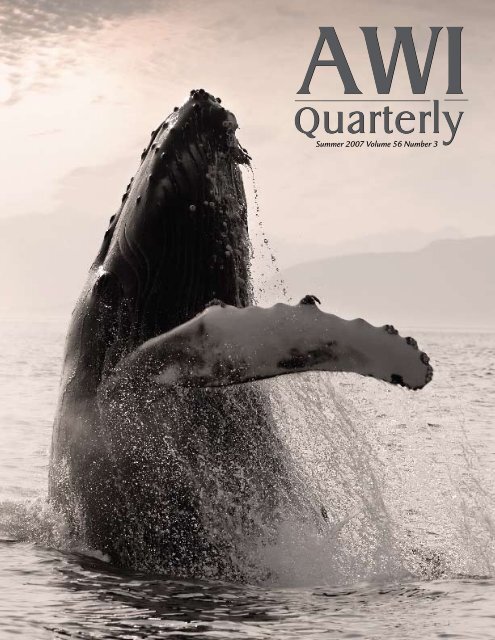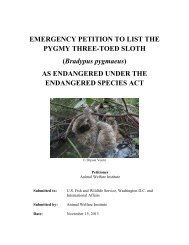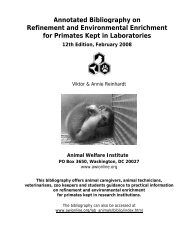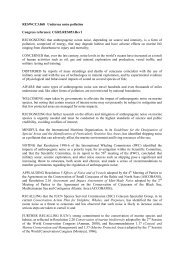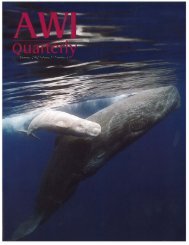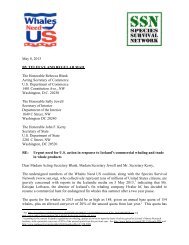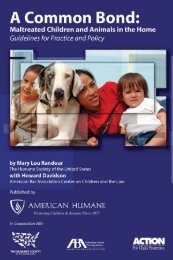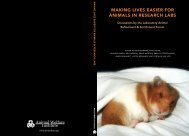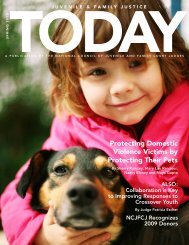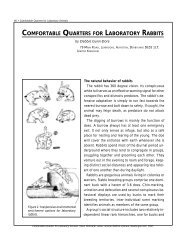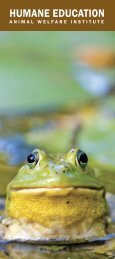Quarterly - Animal Welfare Institute
Quarterly - Animal Welfare Institute
Quarterly - Animal Welfare Institute
You also want an ePaper? Increase the reach of your titles
YUMPU automatically turns print PDFs into web optimized ePapers that Google loves.
AWI AWI<br />
<strong>Quarterly</strong> <strong>Quarterly</strong><br />
Summer 2007 Volume 56 Number 3
Founder<br />
Christine Stevens<br />
directors<br />
Cynthia Wilson, Chair<br />
Barbara K. Buchanan<br />
Penny Eastman<br />
John Gleiber<br />
Charles M. Jabbour<br />
Mary Lee Jensvold, Ph.D.<br />
Cathy Liss<br />
oFFicers<br />
Cathy Liss, President<br />
Cynthia Wilson, Vice President<br />
Charles M. Jabbour, CPA, Treasurer<br />
John Gleiber, Secretary<br />
scientiFic committee<br />
Marjorie Anchel, Ph.D.<br />
Gerard Bertrand, Ph.D.<br />
Roger Fouts, Ph.D.<br />
F. Barbara Orlans, Ph.D.<br />
Roger Payne, Ph.D.<br />
Samuel Peacock, M.D.<br />
Hope Ryden<br />
Robert Schmidt<br />
John Walsh, M.D.<br />
AWI<br />
<strong>Quarterly</strong><br />
Summer 2007 Volume 56 Number 3<br />
international committee<br />
Aline de Aluja, D.M.V., Mexico<br />
Ambassador Tabarak Husain, Bangladesh<br />
Angela King, United Kingdom<br />
Godofredo Stutzin, Chile<br />
Agnes Van Volkenburgh, D.M.V., Poland<br />
Alexey Yablokov, Ph.D., Russia<br />
staFF and consultants<br />
Tracy Basile, Editorial Consultant<br />
Catherine Carroll, Communications Associate<br />
Tom Garrett, Consultant for Rural Affairs<br />
Diane Halverson, Farm <strong>Animal</strong> Advisor<br />
Marlene Halverson, Farm <strong>Animal</strong> Economic Advisor<br />
Christopher J. Heyde, Research Associate<br />
Vivian Leven, Research Associate<br />
Andrea Lococo, Wildlife Consultant<br />
Will Mangum, Graphic Designer<br />
Susan Millward, Research Associate<br />
Serda Ozbenian, Research Assistant<br />
Annie Reinhardt, Information Specialist<br />
Viktor Reinhardt, D.M.V., Ph.D.,<br />
Laboratory <strong>Animal</strong> Advisor<br />
Ava Rinehart, Senior Graphic Designer<br />
Jen Rinick, Public Outreach Associate<br />
D.J. Schubert, Wildlife Biologist<br />
Tracy Silverman, Legal Associate<br />
Wendy Swann, Research Associate<br />
Jill Umphlett, Administrative Assistant<br />
about the cover<br />
The majestic humpback, shown breaching in Alaskan waters (photo by John<br />
Hyde), is one of many whale species whose protections were at stake at this year’s<br />
International Whaling Commission meeting in Anchorage, Alaska. Greenland’s<br />
Native population sought permission to kill humpbacks for subsistence purposes,<br />
and fortunately, the request was denied on the final day of the meeting. However,<br />
the country did receive approval to kill additional minke whales and to add<br />
bowhead whales to its list of targets.<br />
Despite over two decades of a ban on commercial whaling, many whale<br />
species have not yet recovered from the dramatic losses that resulted from brutal<br />
hunts of the past. Aboriginal populations and pro-whaling countries have been able<br />
to sidestep the moratorium, further hindering the animals’ recovery. The <strong>Animal</strong><br />
<strong>Welfare</strong> <strong>Institute</strong> is pressing the US government to stand by its conservation-minded<br />
position on behalf of the whales, and to not make compromises.<br />
Protecting Wildlife at Any Cost<br />
On June 4, the <strong>Animal</strong> <strong>Welfare</strong> <strong>Institute</strong> selected eight outstanding<br />
honorees (listed below) to receive its Clark R. Bavin Wildlife<br />
Law Enforcement Awards. The prestigious award is given to those<br />
who engage in exemplary law enforcement actions to protect species of<br />
wildlife listed in the Appendices of the Convention on International Trade<br />
in Endangered Species of Wild Fauna and Flora (CITES). It is named<br />
after the late chief of the US Fish and Wildlife Service’s Division of Law<br />
Enforcement—a trailblazer who pioneered highly effective undercover<br />
investigations and “sting” operations. At this year’s Conference of the Parties,<br />
certificates of appreciation were personally presented to recipients or their<br />
representatives by CITES Secretariat Willem Wijnstekers.<br />
MR. PAUL CERnIgLIA, US Fish and Wildlife Service Supervisory Wildlife Inspector<br />
MR. YVAn LAFLEUR, Canadian Wildlife Service (retired)<br />
MR. EMMAnUEL MUYEngI, United Republic of Tanzania Ministry of natural<br />
Resources and Tourism Wildlife Division Officer (awarded posthumously)<br />
MR. PAULIn ngOBOBO, Congolese <strong>Institute</strong> for the Conservation of nature<br />
Chief Warden<br />
MR. SAMSOn PARSIMEI OLE SISInA, Kenya Wildlife Service Ranger/Driver (awarded<br />
posthumously)<br />
MR. JOHn T. WEBB, US Department of Justice Environment and natural Resources<br />
Division Attorney<br />
LAST gREAT APE ORgAnIzATIOn, Cameroon, Africa<br />
RAJASTHAn POLICE DEPARTMEnT, India<br />
Board Members Pass the Torch<br />
Marjorie Cooke, an esteemed member of the <strong>Animal</strong> <strong>Welfare</strong> <strong>Institute</strong> (AWI) Board<br />
of Directors since 1974, has stepped down from her post. AWI wishes to thank Mrs.<br />
Cook for her dedicated service to both AWI and the Society for <strong>Animal</strong> Protective<br />
Legislation (SAPL). The sister of the late John Kullberg, a well-known activist and former<br />
director of SAPL, she is a longtime animal advocate herself and worked closely with<br />
Christine Stevens. Roger Fouts, Ph.D. has stepped down from the board as well, but<br />
will fortunately serve on AWI’s Scientific Committee. AWI would also like to welcome<br />
its newest board members, Barbara Buchanan of Vikor Barrier Corp.; Penny Eastman<br />
of Mayer, Brown and Maw; and Mary Lee Jensvold of Central Washington University’s<br />
Chimpanzee and Human Communication <strong>Institute</strong>.<br />
Children concerned about whales drew their feelings<br />
on thousands of colorful postcards presented at this<br />
year’s IWC meeting.<br />
page 6<br />
A ban on DDT, prompted by Rachel Carson’s Silent<br />
Spring, helped save the endangered Peregrine falcon<br />
from extinction.<br />
page 13<br />
Mice who are weaned closer to their<br />
natural weaning age are less likely to suffer<br />
from anxiety.<br />
page 17<br />
Jeff Pantukoff FWS Allison Bechard<br />
animals in the oceans<br />
Fisheries Subsidies at Stake: US proposes cuts...4<br />
Protection for Cook Inlet Belugas?...4<br />
“Dolphin Safe” Label Remains Intact...5<br />
Pact Reached to Curb Bottom Trawling...5<br />
Scientists Shed Light on South Korea’s Whaling Secret...5<br />
Whales Prevail at IWC...6<br />
Drilling Debate: The world’s most endangered whale species may face<br />
a new threat...7<br />
The Sociable Orcas of Kamchatka and the Russian Students Who Care<br />
for Them, by the Far East Russia Orca Project...10-12<br />
animals in the wild<br />
Disappearing Act: Where have North America’s honeybees gone?...7<br />
CITES 2007: Call of the Wild Goes Unanswered...14-15<br />
Beijing Olympics 2008<br />
Part Three: The Deadly Fur Trade in China...20<br />
news from the states and capitol hill<br />
Damaging Dams: Can salmon runs be restored on the Pacific Coast<br />
without dam removal?...8<br />
Brutal Leghold Traps Challenged...9<br />
US Court of Appeals Lets Illinois Plant Resume Horse Slaughter<br />
for Now...9<br />
Provision Would Put Local Authority in Jeopardy...9<br />
in memoriam<br />
Breaking the Silence: AWI looks back on Rachel Carson’s<br />
unprecedented environmental revolution, by John Gleiber...13<br />
animals in the laboratories<br />
Cooperation Counts, by Dr. Andrew Winterborn...16<br />
Small Changes, Big Results, by Allison Bechard...17<br />
humane education<br />
BioSafaris: A Smart Dissection Alternative,<br />
by Lynette Hart...18<br />
books<br />
Just for Elephants...19<br />
Making Lives Easier for <strong>Animal</strong>s in Research Labs...19<br />
Tyger! Tyger!...19<br />
For subscription inquiries or other information, please contact AWI at: P.O. Box 3650, Washington, DC 20027,<br />
phone: (703) 836-4300, facsimile: (703) 836-0400, email: awi@awionline.org, or visit AWI’s website at: www.awionline.org.
news in brief<br />
Protection for Cook<br />
Inlet Belugas?<br />
The National Marine Fisheries Service<br />
(NMFS) proposed in April to list the Cook<br />
Inlet beluga whale as an endangered species<br />
under the Endangered Species Act (ESA),<br />
following a November 2006 Status Review<br />
and Extinction Assessment that found<br />
the population is now at a “26 percent<br />
probability of extinction within 100 years.”<br />
With numbers once estimated at 1,300<br />
in the 1970s, the genetically distinct and<br />
geographically isolated Cook Inlet belugas<br />
began suffering greatly in the 1990s, when<br />
unsustainable subsistence whaling lowered<br />
their count to 653 in 1994 and to less than<br />
350 by 1998. Two years later, the NMFS<br />
attempted to curtail the devastating hunts by<br />
listing the belugas as “depleted” under the<br />
Marine Mammal Protection Act.<br />
However, the belugas have not achieved<br />
the 2 to 6 percent population growth rate<br />
that was expected. Instead, their population<br />
count has “declined 4.1 percent annually<br />
since 1999, with a 5.6 percent annual decline<br />
since surveys started in 1994,” according<br />
Fish gasp for breath and struggle for freedom<br />
after being caught with weighted nets.<br />
National Oceanic and Atmospheric Administration<br />
Researchers tracking Cook Inlet belugas with satellite tags report that their<br />
population numbers continue to fall.<br />
to a recent NMFS news release. Current estimates list the dwindling whale<br />
population at less than 300.<br />
Sadly, threats to these whales far exceed the formerly unregulated hunts.<br />
Today, their precarious state is also subjected to predation, ship strikes,<br />
anthropogenic noise, ice entrapment, fishery interactions, and habitat loss due<br />
to oil and gas development.<br />
Fisheries Subsidies at Stake: US proposes cuts<br />
During recent World Trade Organization negotiations in geneva, Switzerland,<br />
the United States submitted a proposal highlighting the need to cut worldwide<br />
destructive fisheries subsidies in order to stop the collapse of global fish species. The<br />
United States recommends that subsidies distorting trade and endangering marine<br />
life be prohibited by the body. Though not welcomed by all nations, the proposal did<br />
receive a strong backing, and it will be used as a framework in negotiations.<br />
Just days later in the US Congress, a bipartisan group of 13 Senators introduced<br />
a resolution calling for an international ban on fishing subsidies, following a similar<br />
resolution introduced in the House of Representatives in March. Senator Lisa<br />
Murkowski (R-AK), a co-sponsor of the Senate resolution, commented, “Fishing<br />
subsidies have led directly to illegal, unreported and unregulated fishing.”<br />
global fisheries subsidies are estimated to total as much as $34 billion annually.<br />
At least $20 billion of these funds are harmful subsidies that facilitate overfishing,<br />
according to a study by the University of British Columbia. The largest subsidizers of<br />
fisheries are Japan, China and the European Union.<br />
National Marine Mammal Laboratory<br />
Scientists Shed Light<br />
on South Korea’s<br />
Whaling Secret<br />
New research led by Oregon<br />
University’s Dr. Scott Baker confirms<br />
a long-held suspicion that South Korea<br />
is ignoring “unintended” whaling.<br />
Baker’s team used DNA fingerprinting<br />
of minke whale meat to determine<br />
how many individual whales were<br />
killed in recent years as the alleged<br />
bycatch of South Korean fishing nets.<br />
Researchers analyzed samples<br />
of whale meat collected from a<br />
selection of supermarkets in South<br />
Korean coastal cities from 1999 to<br />
2003. It was discovered that the 289<br />
samples were from 205 different<br />
whales, although a catch of only 458<br />
whales was reported to the South<br />
Korean authorities for that period.<br />
“Since the average market ‘halflife’<br />
of whale meat is six weeks, at<br />
most, we should have found far fewer<br />
individuals,” Baker said. Researchers<br />
used a capture-recapture analysis<br />
method to estimate that South Korean<br />
fisherman may have realistically<br />
caught as many as 827 individuals.<br />
South Korea’s consistently high<br />
minke whale bycatch figures—and<br />
the fact that the meat is sold<br />
commercially—imply that the country<br />
is circumventing the 20-year-old<br />
International Whaling Committee (IWC)<br />
moratorium on commercial whaling.<br />
Under IWC rules, the sale of meat<br />
from accidentally captured animals<br />
is permitted, as long as fishermen<br />
report their catches to the government.<br />
However, it is clear from Baker’s results<br />
that South Korea is flouting the rules.<br />
The IWC has taken steps to confront<br />
South Korea about its high bycatch<br />
figures, but the issue will not be addressed<br />
successfully until the country’s<br />
government takes the issue to task.<br />
Fishermen remove ancient coral caught in nets that are used in the<br />
ecologically devastating fishing practice known as bottom trawling.<br />
Pact Reached to Curb Bottom Trawling<br />
The European Union and the 20 nations party to the South Pacific<br />
Regional Fisheries Management Organization have agreed to curb<br />
the practice of bottom trawling in the South Pacific. This huge step in<br />
marine conservation, reached at a meeting in Renaca, Chile, will take<br />
effect on September 30—with particular importance to new zealand,<br />
whose fishermen are responsible for 90 percent of bottom trawling in<br />
the South Pacific.<br />
The highly destructive, indiscriminate fishing method, whereby<br />
boats drag weighted nets along the seabed, produces large numbers<br />
of bycatch and destroys the ocean floor. Slow-growing species such as<br />
the orange roughy and deep-water corals are bottom trawling’s most<br />
vulnerable victims.<br />
The pact will safeguard Pacific Ocean ecosystems, from Australia to<br />
South America and the Equator to the Antarctic, by requiring the presence<br />
of observers (at the expense of the fishing vessel) and banning<br />
bottom trawling without the implementation of precautionary measures<br />
in vulnerable areas. Unfortunately, no agreements were reached at the<br />
meeting to provide relief for the exploited Chilean jack mackerel, which<br />
has seen massive declines from irresponsible fishing practices in<br />
recent years.<br />
“Dolphin Safe” Label Remains Intact<br />
In late April, a three-judge panel of the Ninth US Circuit Court of Appeals<br />
refused to permit the Bush Administration to weaken the “Dolphin Safe”<br />
tuna label, criticizing the US Department of Commerce’s failure to base its<br />
findings on science. The Administration has been trying for years to alter<br />
the Marine Mammal Protection Act to ease rules for the foreign fishing<br />
industry and allow tuna caught with dangerous purse seine nets in Mexico<br />
to be imported to the United States under a false “Dolphin Safe” label.<br />
Following the unanimous decision against this proposal, District Court<br />
Judge Thelton Henderson stated, “[T]his court has never, in its 24 years,<br />
reviewed a record of an agency action that contained such a compelling<br />
portrait of political meddling.”<br />
4 AWI <strong>Quarterly</strong> Summer 2007 5<br />
Greenpeace/Malcolm Pullman/Marine Photobank
whales prevail at iwc<br />
a<br />
t the 59 th International Whaling<br />
Commission (IWC) meeting<br />
held this May in Anchorage,<br />
Alaska, pro-whaling<br />
nations were expected to bristle with<br />
confidence gained from the simple<br />
majority they achieved briefly at last<br />
year’s meeting. But the 2007 gathering<br />
was anticipated anxiously by both<br />
sides of the whaling debate, since all<br />
of the aboriginal subsistence quotas,<br />
including Alaska’s own,<br />
were up for their 5-year<br />
renewal. Participants<br />
were leery of a repeat<br />
of the 2002 meeting,<br />
where aboriginal<br />
whaling quotas were<br />
held hostage by Japan<br />
and its allies in an<br />
attempt to weaken<br />
the US resolve on<br />
commercial whaling.<br />
Susan Millward, D.J.<br />
Schubert and Serda<br />
Ozbenian represented<br />
the <strong>Animal</strong> <strong>Welfare</strong><br />
<strong>Institute</strong>, pressing<br />
the United States not<br />
to capitulate on any<br />
measure in exchange<br />
for the Alaskan bowhead whale<br />
quota—as it did with a vote in support<br />
of a resumption of Japanese small-type<br />
coastal whaling in 2002.<br />
The pro-whaling factions were<br />
unusually reasonable and almost<br />
conciliatory during the first few<br />
days of the meeting, although constant<br />
references to reciprocity hinted at an<br />
expectation of future payback. Nearly<br />
all of the aboriginal whaling quotas,<br />
including the one for Alaskan bowhead<br />
whales, were approved by consensus.<br />
The exceptions were the quotas sought<br />
by the Natives of Greenland, who on<br />
the final day were denied their request<br />
to kill humpback whales, but received<br />
approval for a significant increase<br />
in the number of minke whales and<br />
the addition of bowhead whales to<br />
their hunt.<br />
Japan’s anticipated call for<br />
reciprocity came to a head on the<br />
last day, with a proposed schedule<br />
amendment for a resumption of its<br />
small-type coastal whaling. Japan has<br />
been trying for two decades to get the<br />
IWC to sanction commercial whaling<br />
for its coastal communities, including<br />
Taiji, where the notorious dolphin<br />
drive hunts take place. This year’s<br />
attempt was deftly tailored to mirror<br />
Japanese whaling commissioners huddle during the<br />
debates at the 59 th IWC meeting.<br />
the aboriginal subsistence whaling<br />
that Japan and the other pro-whaling<br />
nations had been so agreeable to earlier<br />
in the meeting.<br />
Japan first tried to remove the<br />
term “aboriginal” from the subsistence<br />
whaling category. When that initiative<br />
failed, it still pursued the subsistence<br />
argument for its coastal people, who<br />
are not indigenous and do not have<br />
subsistence need for whale meat. If<br />
successful, the proposal would have<br />
resulted in a partial lifting of the<br />
moratorium on commercial whaling<br />
and had significant ramifications<br />
for the Convention on International<br />
Trade in Endangered Species of Wild<br />
Fauna and Flora. The issue resulted<br />
in a protracted debate over two days<br />
and was finally defeated. Japan then<br />
threatened to leave the Commission<br />
and was forced to rescind its offer to<br />
host the 61 st meeting in 2009.<br />
A good deal of discussion at the<br />
meeting centered on the future of<br />
the currently polarized IWC, which<br />
is at an impasse because, despite the<br />
moratorium, whales continue to be<br />
killed for commercial purposes at an<br />
increasing rate through loopholes in<br />
the IWC. The pro-whaling factions<br />
favor “normalization” of the IWC,<br />
taking it back to its<br />
origins—which once<br />
led to the mass slaughter<br />
of tens of thousands<br />
of whales and pushed<br />
many to the brink of<br />
extinction—while others<br />
favor “modernization”<br />
and the evolution of<br />
Serda Serda Ozbenian/AWI Ozbenian<br />
the IWC into a nonlethal<br />
use and whale<br />
conservation regime.<br />
The escalating<br />
commercial whale<br />
killing, the inadequacies<br />
of the IWC, and the<br />
lack of progress in<br />
improving whale-killing<br />
methods are deeply<br />
troubling. However,<br />
we are also concerned that efforts to<br />
resolve the perceived impasse may<br />
lead to dangerous compromises. There<br />
are already rumblings of suggested<br />
solutions among traditionally<br />
conservation-minded IWC members<br />
and observers, including accelerating<br />
the development of the Revised<br />
Management Scheme (the rules that<br />
would guide a reinstated practice<br />
of commercial whaling), revisiting<br />
the Irish Proposal of the late 1990s<br />
that sought to ban high seas whaling<br />
and the international trade in whale<br />
products in exchange for coastal<br />
whaling, and the creation of a<br />
whaling-free Southern Hemisphere.<br />
An intercessional meeting has been<br />
proposed to further the negotiations,<br />
and we will attend to ensure that poor<br />
compromises are not made.<br />
Disappearing Act<br />
Where have North America’s honeybees gone?<br />
North American honeybees, crucial to many ecosystems<br />
along the West Coast, have been disappearing at a rate that<br />
is causing major concern.<br />
Drilling Debate<br />
Right whales in the North Pacific have still not recovered<br />
from being ravaged by historic commercial<br />
whaling, and according to US government sources,<br />
fewer than 300 may exist—making them the most endangered<br />
whale species in the world. Unfortunately, a recently<br />
planned lease sale area in Alaska’s Bristol Bay overlaps with<br />
their critical habitat, and proposed exploration would expose<br />
right whales and other marine species to threats such as noise<br />
pollution, oil spills, chemical pollution, vessel collisions and<br />
entanglement with or ingestion of marine debris.<br />
This latest danger first presented itself on January 9,<br />
when President Bush revoked the former moratorium on<br />
Each year, bees and their hives travel across the United<br />
States aboard tractor-trailers to pollinate vegetation<br />
on the West Coast. Because wild pollinators such as<br />
birds and bats are unable to keep up with the demand for<br />
pollination of the increasing dimensions of almond groves<br />
and over 90 varieties of crops from California to Washington<br />
State, migratory beehives and their apiculturists are essential<br />
to the region’s agricultural health. However, in recent<br />
months, millions of bees have abandoned their hives, gone<br />
missing or died.<br />
The predicament, deemed “Colony Collapse Disorder,”<br />
has affected beekeepers in 24 US states and some areas of<br />
Canada, resulting in a loss of 25 percent to over 75 percent<br />
of their hives. Once-burgeoning colonies have become<br />
skeletons of their former selves, often with only the queen<br />
bee and a few of her workers left—with no trace of the<br />
thousands of previous hive inhabitants. Experts are worried<br />
about the implications of this phenomenon, and they fear it<br />
may be far from resolved.<br />
A number of possible culprits are making the suspect<br />
line-up, including bad weather, pesticides or miticides, bad<br />
corn syrup and genetically modified corn. Many believe the<br />
problem may be compounded by the presence of the varroa<br />
mite, a tick-like arachnid that wreaked havoc on apiculture<br />
in 2005. Feeding on adult honeybees and their unborn, the<br />
parasite can destroy a hive by killing young or causing deformities<br />
that weaken colonies and make them more susceptible<br />
to invading pathogens.<br />
For the time being, no remedy has been established. The<br />
Colony Collapse Disorder Working Group, based primarily<br />
at Penn State University, is leading research on the issue, but<br />
The world’s most endangered whale species may face a new threat<br />
drilling in Bristol Bay. While bills to block leasing in the<br />
Bristol Bay are currently pending in both chambers of Congress,<br />
the Bush Administration’s new 5-Year Oil and Gas<br />
Leasing Program of the Minerals Management Service is<br />
currently set to go into effect. The program includes plans<br />
for a lease sale in the Bristol Bay and other US coastal areas.<br />
At this summer’s International Whaling Commission<br />
meeting in Anchorage, Alaska, several governments voiced<br />
concern over the effects of oil and gas drilling on this highly<br />
endangered species. The US government must be pressed<br />
to refrain from subjecting North Pacific right whales to this<br />
potentially devastating action.<br />
6 AWI <strong>Quarterly</strong> Summer 2007 7<br />
www.wikipedia.org<br />
Leigh Hauter
news from capitol hill<br />
brought to you by the Society for <strong>Animal</strong> Protective Legislation<br />
Damaging Dams<br />
Can salmon runs be restored on the Pacific Coast without dam removal?<br />
In a victory for both salmon and<br />
the Endangered Species Act<br />
(ESA), the Ninth US Circuit<br />
Court of Appeals rejected the Bush<br />
Administration’s misguided strategy<br />
for making hydroelectric dams in<br />
the Columbia-Snake River Basin<br />
safe for salmon. Ruling against the<br />
National Oceanic and Atmospheric<br />
Administration claim that it was<br />
not necessary to consider the<br />
effects of the four dams on salmon<br />
because they were built before the<br />
implementation of the ESA, the<br />
judge acknowledged that it might be<br />
necessary to breach the dams to restore salmon populations.<br />
Salmon populations throughout the world are struggling.<br />
The Puget Sound steelhead was recently listed as threatened<br />
under the ESA, and poor management plans for this and other<br />
salmon species are prevalent. One such plan, reintroduced<br />
as H.R. 1769 by Representatives from Washington and<br />
Oregon, is an ill-advised proposal to cull California sea lions<br />
that predate on Columbia River salmon. This proposal only<br />
serves as a short-term fix and ignores the real problem—the<br />
Bonneville Dam—which concentrates the salmon, attracting<br />
the sea lions. The recent court ruling leaves open the<br />
possibility that dam removal is a feasible option that should<br />
be considered.<br />
Fish ladders help salmon head upstream to spawn.<br />
However, the fish may tire on their journey and form<br />
clusters that attract predators.<br />
Bonneville Power Administration<br />
Dams reduce the flow of water,<br />
obstruct salmon migration routes,<br />
and concentrate the fish, making<br />
them vulnerable to predators. Over<br />
the years, many raging rivers have<br />
been transformed into stagnant,<br />
warm lakes with depleted oxygen<br />
levels. This scenario is playing<br />
out in many areas on the West<br />
Coast. Although dams are harmful<br />
for salmon, their removal is<br />
controversial since they provide a<br />
clean source of power and aid in<br />
flood control and irrigation<br />
for farmers.<br />
However, many outdated dams serve no purpose. For<br />
example, the Snake River dams do not store much water due<br />
to sediment build up, and they only produce about 5 percent<br />
of the region’s power. Similarly, the two hydroelectric dams<br />
on the Elwha River were originally built to support a timber<br />
mill that has since been retired; they no longer generate any<br />
power. Thankfully, the process of removing the Elwha River<br />
dams is underway.<br />
The most controversial case by far involves the four<br />
dams in the Klamath River basin, home of the threatened<br />
Coho salmon. In 2002, over 30,000 of these fish perished in<br />
the river due to low river flows caused by river diversions.<br />
For years, there has been a push for the removal of the dams,<br />
which produce electricity for thousands of customers and<br />
irrigation water to farmers.<br />
Earlier this year, the federal government ruled that<br />
PacifiCorp, the owner of the dams, must modify the dams<br />
with fish ladders to accommodate salmon migrations.<br />
However, some estimates show that the removal of the dams<br />
may actually be more cost effective than modifications. No<br />
decisions have yet been made on the future of the dams,<br />
but dam removal projects such as that in the Goldsborough<br />
Creek in Washington State highlight how they can help<br />
salmon. Five years ago, the ancient dams were removed, and<br />
the salmon populations have since flourished, having access<br />
to habitat that had been obstructed for 120 years.<br />
In March, US Representatives Jim McDermott (D-<br />
WA) and Thomas Petri (R-WI) introduced H.R. 1507, the<br />
Salmon Economic Analysis and Planning Act (SEAPA),<br />
calling for more research into the proper methods of salmon<br />
management in the Columbia River Basin, including dam<br />
removal. We commend these legislators and the bipartisan<br />
bill’s 30 cosponsors, as the measure is a necessary step<br />
toward the recovery of depleted salmon runs.<br />
Bonneville Power Administration<br />
Provision Would Put Local Authority<br />
in Jeopardy<br />
This June, a dangerous provision entitled Section 123 was inserted<br />
quietly into the 2007 Farm Bill (H.R. 2419), putting at risk critical<br />
state and local authority to ensure food safety, fight against animal<br />
cruelty, and protect the environment. The measure sought to<br />
prevent a state or locality from “prohibiting an article the Secretary<br />
of Agriculture has inspected and passed, or an article the Secretary<br />
has determined to be of non-regulated status.”<br />
“Section 123 provides the USDA with exclusive jurisdiction<br />
over public health issues and circumvents the ability of the states<br />
to adopt programs that support and promote farmers and rural<br />
economies,” said Bill Wenzel, the national director of the national<br />
Family Farm Coalition’s Farmer-to-Farmer Campaign on genetic<br />
Engineering.<br />
Under a provision such as Section 123, states could be<br />
required to lift their bans on horse slaughter, the brutal production<br />
of foie gras, and the sale of bioengineered food. This was a<br />
major gambit by Big Ag—driving a knife into the remaining<br />
ability of states and counties to control rampaging agribusiness<br />
corporations. It was an attack, above all else, against democracy.<br />
While the latest version of the bill, presented on July 6 in the<br />
House Agriculture Committee Chairman’s Markup Documents,<br />
did not contain Section 123, the Society for <strong>Animal</strong> Protective<br />
Legislation (SAPL) will continue to keep a close eye on the full bill’s<br />
Brutal Leghold Traps Challenged<br />
Millions of furbearing animals each year suffer pain and fear when<br />
caught in highly destructive steel-jaw leghold traps, which are<br />
banned in 89 countries. Companion animals, birds, deer and other<br />
non-target animals fall victim to the indiscriminate trap as well.<br />
An animal caught in its grip might even chew off his or her own<br />
foot to escape on three legs; the trappers call this all-too-common<br />
activity “wring off.” In an effort to protect animals from the cruel<br />
device, Representatives nita Lowey (D-nY) and Christopher Shays<br />
(R-CT) have reintroduced the Inhumane Trapping Prevention Act<br />
as H.R. 1691. The bill seeks to end the use of steel-jaw leghold traps<br />
on animals in the United States by making it unlawful to import,<br />
export, or transport in interstate commerce leghold traps and<br />
articles of fur derived from animals caught using such traps.<br />
Please ask your Representative to cosponsor H.R. 1691 (the<br />
Inhumane Trapping Prevention Act) and H.R. 1507 (the Salmon<br />
Economic Analysis and Planning Act), and to oppose H.R. 1769.<br />
8 AWI <strong>Quarterly</strong><br />
Summer 2007 9<br />
Write to:<br />
YOU CAN MAKE A DIFFERENCE<br />
The Honorable (name)<br />
US House of Representatives<br />
Washington, DC 20515<br />
Any measure that challenges the legislative authority of local<br />
governments could abolish stronger local laws such as state bans<br />
on the use of rBGH in dairy cows. The dangerous growth hormone<br />
can cause painful mastitis and myriad other health problems.<br />
progress. The provision’s removal is a tremendous step to protect<br />
state and local animal protection laws, but there is no guarantee<br />
that similar language will not be inserted into the final version or<br />
slipped through via other legislation.<br />
US Court of Appeals Lets Illinois Plant<br />
Resume Horse Slaughter for Now<br />
Much to our chagrin, the US Court of Appeals for the Seventh<br />
Circuit granted an emergency motion by Cavel International<br />
that allows the DeKalb, Ill.-based horse slaughter plant<br />
to recommence killing horses for sale as meat for human<br />
consumption overseas.<br />
As the only US horse slaughter plant still in operation,<br />
Cavel was previously forced to shut its doors in late June<br />
when US District Court Judge Frederick Kapala denied its<br />
request to continue to evade prosecution under a recently<br />
enacted Illinois state law that criminalizes the slaughter of<br />
horses for human consumption.<br />
In May, Cavel filed suit in federal court to challenge the<br />
new law’s enforceability, but on July 5, Judge Kapala ruled<br />
that the law was constitutional and thus, enforceable.<br />
Cavel has appealed Judge Kapala’s latest decision to<br />
the US Court of Appeals, and while its appeal is pending,<br />
the slaughterhouse may once again slaughter horses for<br />
human consumption. The Court granted the plant’s request<br />
for an injunction without a hearing, just two days after the<br />
slaughterhouse filed its motion.<br />
The <strong>Animal</strong> <strong>Welfare</strong> <strong>Institute</strong> is represented by the nationally<br />
renowned law firm Patton Boggs. We will continue to do<br />
our utmost to ensure that the law passed in Illinois to stop this<br />
brutal trade within the state’s boundaries is put in force.<br />
People for the Ethical Treatment of <strong>Animal</strong>s
The Sociable orcaS of KamchaTKa<br />
10 AWI <strong>Quarterly</strong><br />
Tatiana Ivkovich<br />
Erich Hoyt<br />
...and the Russian Students Who Care for Them<br />
Background: Tatiana Ivkovich<br />
by the far east russia orca project<br />
“<br />
Kawoof!” is the sound of an orca, or killer whale,<br />
spouting. It seems to echo off the big snow-capped<br />
Viluchinsky volcano in Avacha Gulf, southeast Kamchatka,<br />
Russia. Three researchers on our team, sitting in an inflatable<br />
boat, turn their heads. Where there is one orca, there are<br />
usually many more, for these are highly social mammals.<br />
As almost a dozen orcas from the Avacha clan explode<br />
in quick sequence at the surface and their spouts drift toward<br />
the boat, our team takes their photographic identification shots<br />
(photo at top far left). Another part of the team sitting in a boat<br />
nearby drops a hydrophone into the water to record the dialects<br />
of this orca pod—and to try to puzzle out the meaning of the<br />
orcas’ complex communication (top photo, second to left).<br />
For several years, the <strong>Animal</strong> <strong>Welfare</strong> <strong>Institute</strong> (AWI) has<br />
helped support the Far East Russia Orca Project (FEROP), a<br />
group of university students in Moscow, St. Petersburg and<br />
Vladivostok. Our project was the vision of Russian marine<br />
mammal researcher Alexander Burdin, Japanese researcher<br />
Hal Sato and Whale and Dolphin Conservation Society Senior<br />
Research Fellow Erich Hoyt. Beginning with a pilot project<br />
in 1999, the team has grown with every summer, extending<br />
the chance to Russian students to work with a species that had<br />
never been studied in Russia. In the Kamchatka Peninsula in<br />
Hal Sato<br />
the Russian Far East, there is little support for whale research.<br />
Through the project, three of our students have received<br />
Master’s degrees (including Tanya Ivkovich, pictured at<br />
top left), and two (Olga Filatova and Karina Tarasyan) have<br />
received Ph.D.s. More are in progress. The team has separately<br />
identified and catalogued more than 400 individual orcas using<br />
digital dorsal fin photographs (top two photos at right), found<br />
important feeding habitat, and identified fish-eating resident<br />
and seal-eating transient-type orcas similar to the different<br />
ecotypes found in the well-studied orca populations in the<br />
eastern North Pacific off the United States and Canada.<br />
Our acoustics expert Olga Filatova has also identified<br />
sound dialects, with each pod or family group having some<br />
unique sounds passed down through the mothers—similar to<br />
the dialect system found in the eastern North Pacific, albeit<br />
with Russian accents. We spend a lot of time with the mothers<br />
and calves, as well as the big bulls, who, despite their size,<br />
stay beside their mothers for life. We have come to know them<br />
and have given them names, including Humpy, Hookie, Jeka,<br />
Brodyaga, Misha and Stepa.<br />
In 2003, the project changed from a simple science<br />
project to a strongly conservation-minded science project. Our<br />
original thinking was that it was necessary to train Russian<br />
Summer 2007 11<br />
Tatiana Ivkovich
iologists to work in their country, both in terms of science and<br />
conservation; otherwise, all would be lost. We knew that killer<br />
whales in Russia were under threat of capture for aquariums in<br />
Japan, China, the United States and other locations. In September<br />
2003, a few days after we left our camp, two young female orcas we<br />
knew were taken and killed by aquarium captors. One suffocated<br />
in the nets during capture. The other was transported on the ship to<br />
a makeshift pen and then flown nine time zones to the Black Sea,<br />
where she died 13 days later from an infection. We were devastated.<br />
Since then, we have worked to reduce and marginalize the<br />
quotas. The captors are no longer allowed to work in our study<br />
area off eastern Kamchatka. There have been no successful capture<br />
attempts since 2003, although some permits are still being granted.<br />
At the same time, we have published articles in local newspapers<br />
and magazines, and we have talked to people about “our” orcas. We<br />
feel that if people could get to know orcas as individuals, the way<br />
we know them, things would be different. We are looking forward<br />
to the day when there will be no quotas and killer whales will be<br />
celebrated in Russia.<br />
Tatiana Ivkovich<br />
The Wildlife Paradise<br />
of Kamchatka<br />
Our study site for the Far East Russia Orca Project<br />
off southeast Kamchatka is a marine wildlife<br />
paradise. Based on a small rocky island just off<br />
the coast, our team lives among tens of thousands<br />
of seabirds. Sometimes we rescue and help save<br />
tufted puffins or other small birds who get into<br />
trouble (photo at top right). We also encounter<br />
common murres (photo below at left) and pigeon<br />
guillemots (photo below at right). Largha seals<br />
(center photo below) live all around the island and<br />
are frequently curious neighbors who watch us in<br />
the evenings as we clean our cameras, eat dinner,<br />
and prepare for the next day.<br />
For more information about the project, see www.russianorca.com or contact erich.hoyt@mac.com. In addition to AWI’s continuing support, FEROP has<br />
been funded by the Whale and Dolphin Conservation Society, Humane Society International, Sacher Trusts, Project Thursday’s Child, St. george’s School<br />
for girls, and Cetacean Society International. In 2002, the project won the prestigious Klüh Prize for Innovation in Art and Science from germany.<br />
Tatiana Ivkovich<br />
Tatiana Ivkovich<br />
Tatiana Ivkovich<br />
b r e a k i n g the silence<br />
AWi looks back on rachel Carson’s<br />
unprecedented environmental revolution<br />
by John gleiber<br />
here are all kinds of<br />
revolutions—political,<br />
cultural, historic and economic—but<br />
the most effective ones are unexpected.<br />
In 1962, this was proven by the earthshattering<br />
uprising brought about by<br />
a woman working in quasi-anonymity<br />
for the US government. Rachel Carson<br />
that year published Silent Spring, a<br />
lodestar of intelligent analysis of the<br />
destruction of our environment that<br />
had been engendered by “omniscient”<br />
scientists.<br />
In her book, Ms. Carson skillfully<br />
presented the effects of pesticides on<br />
animals and the environment, accusing<br />
industry and the government of<br />
spreading misinformation. She revealed<br />
that the chemical DDT was causing<br />
birds to have reproductive problems<br />
and lay eggs with thinner shells. Today,<br />
because of her influence, we are aware<br />
of the perils that chemicals pose to the<br />
environment. Sometimes promptly<br />
and sometimes slowly, we have made<br />
strides in mitigating the horrendous<br />
toll humanity has paid for years of<br />
indiscriminate poisoning.<br />
I still remember<br />
a time when DDT<br />
was as ubiquitous as<br />
toothpaste—and as<br />
zealously employed. I<br />
go back to a time in our<br />
history when the loss<br />
of birds, other wildlife<br />
and good health was an<br />
accepted way of life.<br />
Academia and science can<br />
be as unseeing as any of<br />
us until they are brought<br />
up short by a determined researcher<br />
with a message. One woman, unknown<br />
and unheralded and unappreciated,<br />
turned around the environment<br />
surrounding millions of our fellows<br />
and brought some equilibrium to the<br />
man vs. nature debate. Not a research<br />
team, not a committee, not a think<br />
tank—one woman.<br />
Looking back on the trajectory of<br />
this beacon of common sense, one can<br />
only marvel at how we were so willfully<br />
blind to the irrefutable proof that<br />
Ms. Carson put forth. That the reaction<br />
to Silent Spring was mixed is to put it<br />
as mildly as possible. TIME magazine<br />
branded it “nonsense,” while Supreme<br />
Court Justice William O. Douglas<br />
hailed it as “the most important chronicle<br />
of this century for the human race.”<br />
My favorite comment is from her editor,<br />
Paul Brooks: “… Rachel Carson<br />
somehow succeeded in making a book<br />
about death a celebration of life.”<br />
Tributes poured in. Sir Julian<br />
Huxley—yes, that Huxley—saluted<br />
her work. He described it to his brother<br />
Aldous, who said, “We are destroying<br />
half the basis of English poetry.”<br />
Upon Ms. Carson’s death on April<br />
16, 1964, the Boston Globe ran an<br />
editorial simply headlined, “The Power<br />
of a Woman.” Nearly three decades<br />
later, The Christian Science Monitor<br />
quoted her in an article about the<br />
use of pesticides on vegetable crops,<br />
noting that we were living in “an era<br />
dominated by industry, in which the<br />
right to make money at whatever cost<br />
to others is seldom challenged.” We<br />
must remember Ms. Carson’s message<br />
in our own era of global warming<br />
and other threats to animals and the<br />
environment.<br />
Marine biologist and nature writer rachel Carson joined the <strong>Animal</strong> <strong>Welfare</strong><br />
institute (AWi) Advisory board in 1960. Two years later, she published the<br />
book Silent Spring, effectively launching the modern environmentalism<br />
movement. Ms. Carson was awarded AWi’s 1962 Albert Schweitzer<br />
Medal for her contribution to the protection of animals from dangerous<br />
pesticides such as DDT. Sadly, she died of cancer at a young age in 1964. To<br />
commemorate the 100 years since her birth in 1907, we celebrate her legend.<br />
12 AWI <strong>Quarterly</strong><br />
Summer 2007 13<br />
Photo: National Oceanic and Atmospheric Administration
CITES 2007<br />
Call of the Wild Goes Unanswered<br />
Only minutes into the opening ceremony of the “Call<br />
of the Wild”-themed 14 th Conference of the Parties<br />
(CoP 14) to the Convention on International Trade in<br />
Endangered Species of Wild Fauna and Flora (CITES), it was<br />
clear that hopes of gaining trade protections for some of the<br />
world’s most imperiled species would become overshadowed<br />
by concerns about livelihoods, politics and profits. While<br />
these are not CITES criteria for protecting wild species<br />
from international trade, what the treaty says and how it is<br />
interpreted are entirely different things. In reality, livelihood<br />
concerns often trump trade restrictions, and science takes a<br />
back seat to politics and profit. Over the course of the twoweek<br />
meeting, the “Call of the Wild” became a cry for help, as<br />
several critically imperiled species were denied international<br />
protection.<br />
Not long after the pomp and circumstance of the opening<br />
ceremony, oft-repeated claims of science as the standard for<br />
CITES listing decisions were cast aside in favor of backroom<br />
political deals. A proposal by Mozambique to double its sporthunted<br />
leopard export quota to 120 individuals, despite relying<br />
on a questionable 20-year-old population estimate of leopards,<br />
was approved by consensus—to the delight of the Safari Club<br />
International and its cadre of globetrotting trophy hunters.<br />
Similarly, Uganda, which also relied on two decades-old data,<br />
was awarded an export quota of 28 sport-hunted leopards to<br />
sell to wealthy trophy hunters. Fortunately, a proposal by the<br />
United States to remove the bobcat’s CITES protection was<br />
rejected by a large majority, due to concerns about several<br />
look-alike species that could be drastically affected by<br />
unregulated trade.<br />
While evidence of declining populations, localized<br />
extinction, habitat loss, illegal poaching and international trade<br />
is mounting, Algeria’s effort to uplist the Barbary red deer to<br />
Appendix II was unsuccessful. The country was successful<br />
in gaining Appendix I protection for both the slender-horned<br />
and Cuvier’s gazelle, ostensibly halting the trade in these<br />
declining species. An Appendix I listing was also approved for<br />
the Guatemalan beaded lizard, which is considered one of the<br />
most endangered reptiles in the world, with no more than 250<br />
individuals remaining in the wild.<br />
For marine species, the results of CoP 14 were a mixed<br />
bag—largely because of a “turf war” between CITES and the<br />
Food and Agriculture Organization (FAO) over the listing of<br />
marine species. Claiming expertise in marine species management,<br />
the FAO’s alleged scientific review of marine fish proposals<br />
blocked the listing of a number of species desperately<br />
in need of international trade protections. The failed CITES<br />
Appendix II listing proposals for the porbeagle shark and spiny<br />
dogfish are particularly alarming, given the 90 to 99 percent<br />
decline of these species in some areas. In addition to the FAO’s<br />
scientifically questionable conclusions, many countries engaged<br />
in or profiting from their continued trade further jeopardized<br />
their survival by opposing the listings.<br />
Appendix I and II listings were approved for the sawfish<br />
species and European eel, respectively. The sawfish trade<br />
ban, except for a small live trade exemption in Australia, was<br />
overdue considering that this species has experienced a 90<br />
percent decline and has been extirpated from many parts of<br />
its former range. It is hoped that the Appendix II listing for<br />
the eel will reverse its significant decline caused by overexploitation<br />
for international trade and habitat threats. US<br />
efforts to list red and pink corals—heavily exploited<br />
for the manufacturing of jewelry—in Appendix<br />
II succeeded initially in committee, only to be<br />
defeated in plenary after a night of intense<br />
lobbying by Tunisia, other user countries and the<br />
coral industry.<br />
For the beautiful Banggai cardinalfish,<br />
Indonesia’s eleventh hour decision to<br />
oppose an Appendix II listing sought by<br />
the United States and a complete lack<br />
of support from other countries forced<br />
a withdrawal of the proposal before<br />
a vote. In opposing this listing,<br />
Indonesia claimed it was taking steps<br />
to protect this species and pleaded with the other delegates<br />
to not harm the Banggai people’s “hopes and dreams” by<br />
listing the species. Indonesia did not disclose that it has not<br />
proactively protected the cardinalfish or its habitat, or that only<br />
60 fishermen are involved in the cardinalfish trade. Without<br />
international protection, some experts predict that this species<br />
could become extinct within a decade, if collection for the<br />
aquaria trade continues at it present pace. Ironically, the<br />
species will soon be listed as “endangered” by the International<br />
Union for the Conservation of Nature—though this designation<br />
provides no protection from trade.<br />
While the debate was intense on many species proposals,<br />
elephants, whales and tigers generated the most heated<br />
controversies. There was concern that China would seek<br />
approval to reopen its domestic tiger trade, using parts from<br />
the 5,000 tigers imprisoned on its tiger farms (See AWI<br />
<strong>Quarterly</strong>, Spring 2007). Though tiger farm owners continue<br />
to push China to rescind the 1993 trade ban, claiming that<br />
trade in farmed tiger parts will help save wild tigers, nearly<br />
all of the world’s tiger experts agree that it would cause the<br />
extinction of tigers in the wild. Fortunately, CITES member<br />
countries made it clear to China that lifting the tiger trade ban<br />
was unacceptable and would doom wild tigers to extinction.<br />
However, China questioned the authority of CITES to dictate<br />
its domestic trade decisions and intimated that it may still<br />
reopen the domestic trade in tiger parts in the future.<br />
After Japan’s stinging defeats only days earlier at<br />
the International Whaling Commission (IWC) meeting in<br />
Anchorage, its efforts to undermine CITES protections for<br />
On July 18, 1989, Kenya’s then-President Daniel<br />
Troitich Arap Moi burned 12 tons of stockpiled ivory to<br />
demonstrate a commitment to saving elephants.<br />
Bobcats retained their CITES protection after<br />
a proposal by the United States was rejected<br />
overwhelmingly at the 2007 annual meeting.<br />
whales provided for both tense and comical theatre. CITES<br />
member countries roundly rejected Japan’s proposal to review<br />
the listing designation of all great whales—a first step toward<br />
downlisting whale species in order to resume international<br />
trade in their products. At the same time, a slim majority<br />
approved language introduced by Australia to prohibit any<br />
such CITES species reviews until and unless the IWC lifts the<br />
moratorium against commercial whaling. In the subsequent<br />
plenary session, Norway, Iceland, and several of Japan’s<br />
“puppet nations” engaged in a belabored exercise in procedural<br />
gymnastics, attempting to reopen Australia’s proposal for<br />
renewed discussion. They failed, and Australia’s proposal<br />
survived intact.<br />
Unlike the whale debate, deliberations over elephants and<br />
the ivory trade occurred behind closed doors. Delegates and<br />
ministers from the African countries met repeatedly to develop<br />
a compromise between contrasting ivory trade proposals.<br />
Kenya and Mali, recognizing the significant increase in<br />
elephant poaching incidents, proposed a 20-year moratorium<br />
on ivory trade. Conversely, several southern African countries,<br />
including Botswana, South Africa, Zimbabwe and Namibia,<br />
sought approval for an annual ivory trade. The resultant deal<br />
called for a 9-year moratorium on ivory trading, but only after<br />
a one-off sale of nearly all stockpiled ivory from the four<br />
countries with Japan. Many experts believe creating such a<br />
legal market for ivory will increase the incidence of poaching<br />
to feed the increasing demand for ivory in the Far East. Illegal<br />
ivory can be laundered easily when so-called “legal” ivory is<br />
permitted in the market.<br />
After two weeks of debate and controversy, only a<br />
handful of species were provided increased protection from<br />
international trade. Even those species’ future depends on<br />
the commitment of CITES member countries to implement<br />
the treaty—something that few countries appear to embrace.<br />
Though CITES may be the best tool available to control the<br />
international trade in wild species, it is not a panacea to reverse<br />
the severe and ongoing loss of biodiversity on the planet.<br />
14 AWI <strong>Quarterly</strong> Summer 2007 15<br />
leopard: Stuart Taylor/www.Dreamstime.com; ivory: Safarimate<br />
Lana Smith/dreamstime.com
Our study was conducted on caged animals during<br />
their semi-annual testing and physical exam for<br />
tuberculosis, with the goal of comparing the<br />
efficacy of two orally dosed anesthetic regimens for chemical<br />
immobilization in rhesus macaques versus the standard<br />
protocol of intramuscular ketamine. The effects of the dosing<br />
route on hematological stress were also evaluated.<br />
One of the major components for the success of this<br />
study required that all animals accept oral dosing, which was<br />
achieved through operant conditioning—what is commonly<br />
known as positive reinforcement. The 5-day-a-week, monthlong<br />
task of training the<br />
macaques was broken<br />
down into three steps. The<br />
first step of shaping the<br />
desired behavior involved<br />
establishing a positive<br />
relationship between<br />
the macaque and the<br />
trainer. This objective was<br />
achieved when the animal<br />
approached the front of<br />
the cage voluntarily after<br />
the trainer entered<br />
the room.<br />
Step two involved restricting<br />
the animal to the<br />
front quarter of the cage<br />
by using the squeeze device.<br />
A raisin was placed<br />
on the tip of a fruit juice-<br />
filled 5 cc syringe and presented<br />
to the animal. This<br />
encouraged the animal to<br />
approach the syringe with<br />
his or her mouth or fingers<br />
to take the fruit, at which<br />
point the trainer gently<br />
squirted a little juice into<br />
the macaque’s mouth or<br />
hand. This process was repeated until all of the animals voluntarily<br />
approached the syringe and drank all of the juice. Once<br />
an animal readily suckled or licked the juice from the syringe,<br />
he or she was rewarded with a grape or small piece of fruit. Finally,<br />
in step three, animals were offered the juice without being<br />
confined to the front of the cage. Once again, the macaques<br />
were rewarded for drinking all of the juice from the syringes.<br />
By the end of the month, 16 of the 18 animals (88.89<br />
percent) had been successfully taught to drink juice from a<br />
syringe. Four of the 18 animals were immediately interested in<br />
the syringe and readily came forward to drink the liquid. The<br />
remaining 14 required more intensive operant training, with<br />
12 finally succeeding. The time constraint was the limiting<br />
factor in training the remaining two animals. One month was<br />
not sufficient, although some progress was made. They would<br />
both approach the front of the cage when observed and would<br />
take treats from the end of the syringe, though they would not<br />
drink. Several different liquids were used to see if this would<br />
facilitate training, without success.<br />
Throughout the month, each training session lasted a<br />
maximum of five minutes, and if the desired behavior was<br />
achieved in less time, the session was stopped. The average<br />
total training time per animal, excluding the time invested in<br />
the two animals who did not successfully accept oral dosing,<br />
was 13 ± 8.6 minutes. The shortest training period was three<br />
minutes, with the animal accepting oral dosing during the first<br />
training session. The<br />
longest training period<br />
was 35 minutes.<br />
Operant<br />
conditioning for oral<br />
dosing has many<br />
applications. If<br />
macaques are trained<br />
to accept liquid from<br />
syringes, they can<br />
receive test compounds<br />
in pharmaceutical<br />
testing by voluntarily<br />
Cooperation Counts<br />
Dr. Andrew Winterborn of the University<br />
of Rochester Medical Center trains rhesus<br />
macaques to take juice from syringes.<br />
Andrew Winterborn<br />
accepting the liquid<br />
and being rewarded<br />
for it. This functions<br />
as an alternative to<br />
the current practice of<br />
gavage. In addition, oral<br />
dosing has implications<br />
for husbandry and<br />
veterinary procedures.<br />
If an animal is trained<br />
to drink from a syringe,<br />
medication can be<br />
given orally instead<br />
of injected. In all<br />
instances, the primate is<br />
an active participant in<br />
the procedure. The key to effective operant training is finding<br />
a palatable fluid for each individual animal and identifying a<br />
reward when they ingest all of the fluids.<br />
Successful oral dose training allowed for the evaluation of<br />
the efficacy of oral dosing for sedation. Our study concluded<br />
that oral dosing alone was not sufficient to achieve a state<br />
of sedation to allow for safe handling. However, animals<br />
who received ketamine and medetomidine, followed by<br />
supplemental intramuscular ketamine, did have a smoother<br />
induction and recovery. Serum cortisol and glucose levels<br />
were unchanged across all groups. In contrast, differences<br />
were observed in the leukogram profiles, indicating that<br />
oral dosed animals experienced a higher level of stress. It<br />
was hypothesized that this was a result of their light state of<br />
anesthesia, not a direct result of oral dosing.<br />
L<br />
aboratory mice<br />
are one of the<br />
most commonly<br />
used animals in<br />
biomedical research,<br />
meaning that relatively<br />
small changes to their<br />
early husbandry could<br />
have lasting effects on<br />
the health and wellbeing<br />
of millions of<br />
animals. The practice<br />
of early weaning, for<br />
example, can be a cause<br />
of stress for almost any<br />
animal, and it is typical<br />
for young mice in the<br />
laboratory. They are<br />
usually separated from<br />
their mothers at the age<br />
of 3 weeks, whereas<br />
they would not disperse<br />
in nature until about a<br />
month later.<br />
Mouse pups are born in a highly immature state and<br />
depend completely on their mothers for survival. The standard<br />
management-imposed separation of the mother and young<br />
occurs during a fragile developmental period of neural and<br />
behavioral organization. Along with curtailed maternal care,<br />
modified social milieu due to early separation of the sexes is<br />
a consequence of disrupting the family unit at this age. These<br />
influential effects of maternal and social deprivation are often<br />
largely overlooked in relation to welfare and as factors in<br />
research results.<br />
We weaned C57Bl6 (B6) and CD-1 litters at either<br />
the standard 21 days or the more naturalistic 35 days to<br />
investigate the effects of this artificial, premature disruption<br />
to the mother-young bond. Offspring from 14 litters were<br />
screened for neophobia and anxiety (e.g. elevated plus-maze,<br />
open field, acoustic startle response) between 2 to 3 months<br />
of age, and for stereotypic behavior (e.g. bar mouthing,<br />
somersaulting) and alopecia at an age of 6 to 7 months. The<br />
hypothesis was that delaying weaning age would improve<br />
adult welfare. The chosen strains were two of the most<br />
commonly used inbred and outbred mouse lines, while<br />
selected behavioral parameters bridge the previously distinct<br />
fields of neuroscience and welfare.<br />
Results indicate that delaying weaning reduces adult<br />
anxiety, as measured by an elevated plus-maze (p
BioSafaris: A Smart Dissection Alternative<br />
by LYNETTE HART, University of California at Davis<br />
With primary startup funding<br />
from the <strong>Animal</strong> <strong>Welfare</strong><br />
<strong>Institute</strong>, researchers<br />
from the University of California at<br />
Davis have developed BioSafaris,<br />
a project using the latest interactive<br />
learning technology to address the<br />
current gap in pre-college biology<br />
education. The web-based software<br />
prototype will introduce three body<br />
systems—digestive, respiratory,<br />
and cardiovascular—in intermediate<br />
and high school life science classes.<br />
BioSafaris will present human<br />
anatomy and physiology, along<br />
with examples from comparative<br />
anatomy, key cellular components, and<br />
physiological problems.<br />
Over the past decade, we have<br />
observed a rapid shift away from<br />
consumptive uses of animals for<br />
teaching anatomy and physiology.<br />
New resources have been created to<br />
assist students in learning subject<br />
material and manipulative surgical<br />
tasks without requiring animals<br />
specifically for the procedures.<br />
The exploding World Wide Web,<br />
complemented by the development<br />
of non-invasive imaging methods for<br />
viewing living organisms, presents<br />
enhanced opportunities for creating<br />
learning resources that are readily<br />
accessible to anyone and reusable.<br />
Yet this modernization has not trickled<br />
down to pre-college classrooms,<br />
and younger students are presented<br />
substandard lab materials that fail to<br />
convey the excitement of learning<br />
human and animal biology.<br />
Bequests to AWI<br />
By offering opportunities to ask<br />
questions, modify variables, perturb<br />
the systems to simulate disruptions in<br />
homeostasis, and assess the resulting<br />
effects on the human body, BioSafaris<br />
will make the learning process an<br />
interesting experience for intermediate-<br />
aged students. The software will<br />
allow participants to rotate bodies,<br />
zoom in, change transparency and<br />
explore body parts visually by simple<br />
mouse movements.<br />
Now midway in production,<br />
data for the software prototype have<br />
been extracted and simplified from<br />
the Visible Human dataset from the<br />
National <strong>Institute</strong>s of Health National<br />
Library of Medicine. We are working<br />
on creating sample interactive tools<br />
for simulation, measurement and<br />
perturbation of the three systems.<br />
Focus groups of teachers assess the<br />
web-based prototype in concept and<br />
design. This science education program<br />
will convey the thrill of science and<br />
seek to awaken students’ pursuit<br />
of learning.<br />
In the meantime, a simulation<br />
system supporting the perturbation and<br />
measurement tools for each system<br />
needs to be developed. For example,<br />
the cardiovascular system will be<br />
represented as a graph-like structure<br />
indicating how blood flows through<br />
the human body, and a simulation<br />
that approximates the blood pressure,<br />
heart rate and oxygen levels needs to<br />
be developed in order to provide data<br />
for students to measure. The prototype<br />
design for the simulations of each<br />
of the three systems will elicit the<br />
necessary variables required to produce<br />
the level of realism desired for our<br />
final project.<br />
While the traditional study of<br />
biology in pre-college education<br />
evolved by using animals as a<br />
surrogate method for learning about<br />
human biology, we have chosen<br />
to focus primarily on the study of<br />
humans. BioSafaris will engage<br />
learners on topics relevant to their<br />
families, such as indigestion and<br />
changes in blood pressure or heart rate.<br />
Many students have no further biology<br />
education after high school, and it is<br />
our hope that this learning experience<br />
will assist them in managing their own<br />
lifestyles and lifelong medical care.<br />
PROJECT TEAM:<br />
LYnETTE HART, STUART MEYERS, UC<br />
Davis School of Veterinary Medicine<br />
BERnD HAMAnn, UC Davis <strong>Institute</strong><br />
for Data Analysis and Visualization<br />
(IDAV) and Department of Computer<br />
Science<br />
MARCO MOLInARO, UC Davis Center<br />
for Biophotonics<br />
FRAzIER STEVEnSOn, UC Davis School<br />
of Medicine<br />
BILL STORM, Davis Joint Unified School<br />
District<br />
DAVID WILEY, Stratovan Corporation<br />
MARY WOOD, UC Davis Health<br />
Sciences Library<br />
If you would like to help assure the <strong>Animal</strong> <strong>Welfare</strong> <strong>Institute</strong>’s future through a provision in your will, this general form of bequest is suggested:<br />
I give, devise and bequeath to the <strong>Animal</strong> <strong>Welfare</strong> <strong>Institute</strong>, located in Washington, D.C., the sum of $_____________ and/or<br />
(specifically described property).<br />
Donations to AWI, a not-for-profit corporation exempt under Internal Revenue Code Section 501(c)(3), are tax deductible.<br />
We welcome any inquiries you may have. In cases in which you have specific wishes about the disposition of your bequest,<br />
we suggest you discuss such provisions with your attorney.<br />
Making Lives Easier for<br />
<strong>Animal</strong>s in Research Labs<br />
<strong>Animal</strong> <strong>Welfare</strong> <strong>Institute</strong>, 2007<br />
ISBn: 0938414976<br />
188 pages, $5.00<br />
One free copy is available to all AWI<br />
Members, libraries and lab techs<br />
The <strong>Animal</strong> <strong>Welfare</strong> <strong>Institute</strong> (AWI) just<br />
published Making Lives Easier for <strong>Animal</strong>s in<br />
Research Labs, a new book of discussions that<br />
took place through our online Laboratory<br />
<strong>Animal</strong> Refinement & Enrichment Forum<br />
(LAREF) between October 2002 and May<br />
2007. This book was compiled with the hope<br />
of encouraging compassion in all those who<br />
are responsible for the care and well-being of<br />
animals in research labs. Of more than 5,000<br />
comments posted, approximately 3,000 were<br />
selected because of their practical animal<br />
welfare relevance.<br />
Based on the first-hand experiences of<br />
62 animal technicians, 38 researchers and<br />
13 veterinarians, the book presents ways to<br />
improve housing and handling conditions for<br />
animals in research facilities. Topics include<br />
the human-animal relationship, pair formation<br />
and housing of monkeys, environmental<br />
enrichment for rabbits, bedding for rodents,<br />
exercise for dogs, adoption of animals after<br />
research completion, and minimizing stress<br />
reactions during procedures. Comments<br />
were edited and supplemented with relevant<br />
references from scientific literature. Please<br />
contact us if you would like to obtain a copy, or<br />
view the book online at www.awionline.org/<br />
pubs/LAREF/LAREF-bk.html.<br />
Tyger! Tyger!<br />
by Elizabeth Stanley<br />
Enchanted Lion Books, 2007<br />
ISBn: 1592700683<br />
32 pages, $16.95<br />
In a story based on a reallife<br />
animal sanctuary<br />
located just outside of<br />
Bangkok, Thailand, author<br />
Elizabeth Stanley tells the<br />
tale of Buddhist monks who care for Indo-Chinese<br />
tigers. These animals are one of the world’s most endangered species;<br />
it is estimated that fewer than 250 remain in Thailand, due to poaching<br />
and habitat loss caused by deforestation.<br />
The inspirational tale of monks living in harmony with the<br />
majestic tigers reveals the power of the human/animal bond. When<br />
the tigers become threatened by illegal hunting, a young monk is<br />
compelled to take in two cubs and protect them from harm. Soon there<br />
are as many tigers as monks at the monastery, and the young monk<br />
has a dream to build a peaceful sanctuary that the animals can truly<br />
call home. Both children and adults will be moved by this beautifully<br />
illustrated fable.<br />
Just for Elephants<br />
By Carol Buckley<br />
Tilbury House Publishers,<br />
2006<br />
ISBn: 0884482839<br />
32 pages, $16.95<br />
The Elephant Sanctuary<br />
in Hohenwald, Tenn. is a<br />
100-acre refuge where “retired”<br />
captive pachyderms can roam<br />
free and recuperate from the<br />
stresses of their former lives.<br />
Known for their strong social ties, these intelligent beings suffer<br />
greatly when confined at zoos and circuses.<br />
In Just for Elephants, author Carol Buckley introduces young<br />
readers to Jenny and Shirley, two Elephant Sanctuary inhabitants who<br />
epitomize the species’ tendency to form intense bonds. Shirley is an<br />
injured elephant who used to perform in the circus, and had gone on<br />
to live in a zoo. When brought to the Sanctuary, she quickly reunited<br />
with Jenny, who she had known as a baby elephant in the circus.<br />
The old friends continue to live happily with their elephant family,<br />
demonstrating the animals’ need to live naturally in groups.<br />
18 AWI <strong>Quarterly</strong><br />
Summer 2007 19<br />
reviews
Beijing Olympics 2008<br />
Part Three: The Deadly Fur Trade in China<br />
As the world eagerly gears up for the<br />
2008 Olympics in Beijing, China’s<br />
record of animal cruelty is being<br />
revealed to all. At the country’s fur farms,<br />
foxes, rabbits, mink and other furbearing<br />
animals are exposed to extreme weather<br />
conditions and confined to small, barren<br />
wire mesh cages before being transported<br />
under horrendous conditions to be skinned.<br />
A yearlong undercover investigation<br />
in China’s Hebei Province conducted<br />
by the Environment and <strong>Animal</strong><br />
Society of Taiwan and Swiss <strong>Animal</strong><br />
Protection revealed that, prior to being<br />
<strong>Animal</strong> <strong>Welfare</strong> <strong>Institute</strong><br />
P.O. Box 3650, Washington, DC 20027<br />
Return Service Requested<br />
skinned, the animals are pulled from<br />
their cages, thrown to the ground, and<br />
bludgeoned in an attempt to stun them.<br />
Unfortunately, many animals are still<br />
alive and fully conscious during the<br />
final barbaric process of being hung<br />
up by their legs to be skinned.<br />
China supplies more than half of<br />
the finished fur garments imported for<br />
sale in the United States. While many<br />
fur products contain a “Made in China”<br />
label, additional pelts often move through<br />
international auction houses and are<br />
purchased there before being distributed<br />
Printed with Envirotech ink on recycled paper<br />
As the largest producer of fur<br />
garments in the world, China<br />
is home to countless fur farms<br />
that annually skin millions of<br />
animals—including dogs and<br />
cats—for their fur.<br />
Photos: In Defense of <strong>Animal</strong>s<br />
to manufacturers all over the world.<br />
Products may read “Made in Italy” or<br />
“Made in France,” even though the<br />
fur they contain originated in China.<br />
Moreover, a loophole in the federal<br />
Fur Products Labeling Act exempts<br />
garments that cost less than $150 from<br />
truth-in-labeling provisions. Therefore,<br />
while the import of dog and cat fur is<br />
illegal in the United States, garments<br />
containing such fur can be found in<br />
retail stores. Whether or not you are a<br />
consumer, we hope you will voice your<br />
objections to this gruesome trade.<br />
YOU CAN MAKE A DIFFERENCE<br />
1. If you choose to purchase fur, please ask<br />
retailers for documentation on the true<br />
source of their products. Be aware that fur<br />
products under a certain value may not be<br />
labeled at all.<br />
2. Contact the Chinese ambassador and urge<br />
him to China and urge him to put pressure<br />
on the Chinese government to stop the cruel<br />
practices associated with the treatment of<br />
animals killed for fur. Write to:<br />
His Excellency zhou Wenzhong<br />
Ambassador of the People’s Republic of China<br />
Embassy of the People’s Republic of China<br />
2300 Connecticut Ave. n.W.<br />
Washington, DC 20008<br />
202-328-2574; 202-328-2582 (fax)<br />
Non-Profit Org.<br />
US POSTAGE<br />
PAID<br />
Washington, D.C.<br />
Permit No. 2300


